Towards an Occupancy-Oriented Digital Twin for Facility Management: Test Campaign and Sensors Assessment
Abstract
1. Introduction
2. Literature Review
2.1. Evolution, Main Applications, and Features of Post-Occupancy Evaluations
- Indicative POEs enable to perform overall non-invasive analyses of the building, with selected interviews and photographic surveys to detect critical areas of the building.
- Investigative POEs are more in-depth analyses, and more invasive, with questionnaires, video recordings, and measurement, and they are meant to find causes and consequences of the building performances.
- Diagnostic POEs are the most in-depth analyses, with high levels of user privacy invasiveness and high costs, since they can imply the use of sensor systems to monitor the building, providing data to analyze and optimize building performances and future designs.
2.2. From Building Information Models to Digital Twins for Asset Management
2.3. Evolution of the Digital Twin Concept
2.4. Elements and Characteristics of a Digital Twin
- A physical asset and its virtual counterpart, and data connecting them [23];
- Platform to visualize and manage sensor data, e.g., data and virtual model visualization, analysis, and simulation, which is a key aspect for real-time remote monitoring [23]. The platform should return insights, alerts, or predictions regarding the physical object, thus supporting the decision-making process for the definition of O&M objectives and plans [40,58];
- An acquisition layer such as an IoT system [40,46,53,59], since sensing is a vital component of a DT [60,61,62,63], allowing for continuous monitoring of the physical asset. The virtual component enriched with real-time data regarding the real object represents a dynamic digital replica of the physical asset [46,53];
- Synchronization between physical and virtual component [40], with data flowing at least in one direction allowing for analyses, control, and simulation on the virtual model [20,46,64]. Any change in the monitored characteristics or conditions of the asset is detected and, through data flow, is reflected in the virtual counterpart [20,21];
- Bidirectional communication between physical and virtual part, either with or without humans in the loop, defining a Passive DT or an Active DT, respectively [57]. The knowledge regarding the asset provided by the virtual part results in either human intervention of direct actuation in the real asset [21];
- A DT represents specific and selected aspects of the physical asset, i.e., the subjects of monitoring, simulating, and analyzing, so it does not represent an exact duplication of reality [57];
- Data or status visualization capabilities in order to support the monitoring and decision-making processes by the actors that are in charge of the asset O&M phase [46].
2.5. Occupancy Detection: Analysis of Occupancy Monitoring Systems
3. Research Project Stages
4. Method
4.1. IoT Network of Camera-Based Sensors
- Detection only within field-of-view of the sensors: the BIM model was used to ensure the best positioning and orientation of sensors and to maximize the area covered by the sensors’ field-of-view;
- Privacy issues and Hawthorne effect: the system was set to anonymously monitor users and not to store any images. The user is recognized as a human by the deep learning algorithm embedded in the camera-based sensors and translated into an anonymous agent that cannot be linked to a specific user identity. Consequently, the movements of the user can be anonymously monitored in real time and visualized in the online platform SophyAI, without storing any real image or video recording.
- O: Occupancy values at room-level, i.e., the number of people (p) occupying a room in a certain period of time;
- T: Period of time in which one or more virtual agents occupy a room (minutes/hours).
4.2. Visualization and Analysis Platform
- Visualize real-time occupancy count, i.e., the instantaneous value of O of each space;
- Visualize real-time movements of anonymous virtual agents in a 2D visualization of spaces;
- Store in a DB data regarding the occupancy count of each space (O) and of each day of the week;
- Store in a DB data regarding the room occupancy time (T) during each day of the week.
4.3. Preliminary Analyses Based on Post-Occupancy Evaluations and Building Information Modelling
- Analysis of the geometry of spaces: identification of number of levels of the building and number and geometry of rooms. The geometry of spaces influences the number and position of cameras that are needed to monitor the whole space. In addition, the height of spaces represents the maximum height at which the sensor can be installed, and in turn influences the field-of-view of the sensor;
- Analysis of the functions of spaces: identification of the function of spaces, e.g., bathroom, office, equipment room, etc. The function of spaces influences the definition of the area to be monitored. For example, an equipment room with no variable occupancy, since only technicians can enter the rooms for planned maintenance, does not represent a critical area for occupancy monitoring. As a result, the critical areas whose variable occupancy needs to be monitored are identified. The installation of sensors is limited to the identified critical areas, thus reducing implementation costs of the overall system;
- Analysis of electrical and data and communication systems: analysis of presence, distribution, and equipment of electrical equipment. A non-homogeneous distribution of the electrical and data wiring can in fact represent a limitation for sensors installation;
- Simulation of sensors location and orientation: virtual objects representing the sensors are placed into the BIM model, and each virtual sensor is linked to a field-of-view to simulate the area covered and seen by the sensor itself. The height of installation of the sensor also influences the field-of-view. The simulation of several configurations allows the optimization of number, position, and orientation of sensors, maximizing the area covered by sensors.
4.4. Test Campaign Methodology for Data Quality Evaluation
5. Case Study
5.1. Preliminary Analyses: Sensors Spatial Distribution and Orientation
- Analysis of the functions of spaces;
- Analysis of the geometry of spaces;
- Simulation of sensors location and orientation;
- Analysis of electrical and data and communication systems.
5.1.1. Analysis of the Functions of Spaces
5.1.2. Analysis of the Geometry of Spaces and Simulation of Sensors Location and Orientation
- The first solution considered two standard cameras at the two opposite sides of the corridor. Each corridor would be entirely monitored by two sensors at the same time, but in the central area, the detection could be less precise due to the distance from the sensors. In addition, cameras would have difficulty in monitoring areas near the end of the corridor, i.e., the area close to each sensor. Users passing through a door near the end of the corridor would be extremely distorted in the view of the nearby camera, making recognition difficult.
- The second solution considered two standard camera-based sensors located at 1/3 and 2/3 of the corridor. This solution allows for a better monitoring of the end areas of corridors, but limits the simultaneous monitoring by both sensors to the central area only.
- The third solution implied the use of a single 360-degree camera at the center of the corridor. Those kind of sensors are more expensive than standard cameras, but the total cost would be comparable, since this solution would consider only one sensor instead of two. This solution results in the corridor being entirely monitored by a single camera.
5.1.3. Analysis of Electrical and Data and Communication Systems
5.2. Test Campaigns
6. Results and Discussion
- Difficulty of the system in detecting two people entering in a room close together and/or quickly;
- Issues in the detection of two people walking in a corridor towards a sensor, since the person further away from the camera is not detected. The error occurs in all areas not covered by the fields of view of two cameras at the same time;
- Irregular detection of users with a continuous detection/disappearance of a moving user due to the high distance between the camera and the to-be-detected area. This issue was in fact detected mainly in areas far from the sensors.
- Automatism that brings the count back to 0 when the displayed count is negative;
- Possibility to manually reset rooms that present a wrong count;
- Automatic routine that records the occupancy data after a minimum user presence (i.e., 5 min) for office spaces only.
- Difficulty in detecting users at the end of the corridors due to the presence of windows. The intense natural light generates a high luminous contrast between the central part of the corridor and the terminal part. The light contrast of the two zones generates an unstable detection of users. The detecting issue related to lighting contrasts of different zones of the building was only discovered in the second test campaign and not during the previous test. Considering the location of the building (Milan, 45°28′46.8″ N 9°13′48.0″ E), the sun is low in the sky during the winter season. This can generate detection issues related to lighting contrast, which cannot be detected during others seasons of the year, which explains the newly emerged detection issue, since the first test campaign had been performed in May. Therefore, conducting several tests during different periods of the day and year is strongly recommended for camera-based sensor systems. A preferable solution to overcome the lighting contrast issue is modifying the settings of the camera to correct the lighting contrast.
- Failure in detecting the users’ entrance due to other kind of obstructions such as open doors. Specifically, the doors opening towards the corridor can obstruct the view of the adjacent room entrance, preventing the system from registering users entering the room (Figure 11). The issue can only be managed by adding new cameras to cover the unexpected blind spots. The issue was unexpected, since doors are usually kept closed when offices are occupied.
- Issues in the recognition of cleaning service company employees. The system struggled in detecting the workers due to the presence of the cleaning trolley, which impeded a complete view of the operator. The cleaning trolley provoked an incorrect counting of entries, exits, and occupancy of the rooms. To overcome the issue, the recognition algorithm can be optimized and trained to correctly recognize the cleaning service operator, by recognizing the cleaning trolley.
7. Conclusions and Further Developments
Author Contributions
Funding
Institutional Review Board Statement
Informed Consent Statement
Data Availability Statement
Acknowledgments
Conflicts of Interest
References
- National Research Council. Stewardship of Federal Facilities: A Proactive Strategy for Managing the Nation’s Public Assets; The National Academies Press: Washington, DC, USA, 1998. [Google Scholar]
- Zimmerman, A.; Martin, M. Post-occupancy evaluation: Benefits and barriers. Build. Res. Inf. 2001, 29, 168–174. [Google Scholar] [CrossRef]
- Bento Pereira, N.; Calejo Rodrigues, R.; Fernandes Rocha, P.; Bento Pereira, N.; Calejo Rodrigues, R.; Fernandes Rocha, P. Post-Occupancy Evaluation Data Support for Planning and Management of Building Maintenance Plans. Buildings 2016, 6, 45. [Google Scholar] [CrossRef]
- Dong, B.; Yan, D.; Li, Z.; Jin, Y.; Feng, X.; Fontenot, H. Modeling occupancy and behavior for better building design and operation—A critical review. Build. Simul. 2018, 11, 899–921. [Google Scholar] [CrossRef]
- Kim, J.; de Dear, R. Nonlinear relationships between individual IEQ factors and overall workspace satisfaction. Build. Environ. 2012, 49, 33–40. [Google Scholar] [CrossRef]
- Agha-Hossein, M.M.; El-Jouzi, S.; Elmualim, A.A.; Ellis, J.; Williams, M. Post-occupancy studies of an office environment: Energy performance and occupants’ satisfaction. Build. Environ. 2013, 69, 121–130. [Google Scholar] [CrossRef]
- Straka, V.; Aleksic, M. Post-occupancy evaluation: Three schools from Greater Toronto. In Proceedings of the PLEA2009–26th Conference on Passive and Low Energy Architecture, Quebec City, QC, Canada, 22–24 June 2009. [Google Scholar]
- Rogage, K.; Clear, A.; Alwan, Z.; Lawrence, T.; Kelly, G. Assessing Building Performance in Residential Buildings using BIM and Sensor Data. Int. J. Build. Pathol. Adapt. 2019. [Google Scholar] [CrossRef]
- Wang, W.; Hong, T.; Xu, N.; Xu, X.; Chen, J.; Shan, X. Cross-source sensing data fusion for building occupancy prediction with adaptive lasso feature filtering. Build. Environ. 2019, 162, 106280. [Google Scholar] [CrossRef]
- De Wilde, P. The gap between predicted and measured energy performance of buildings: A framework for investigation. Autom. Constr. 2014, 41, 40–49. [Google Scholar] [CrossRef]
- Marzouk, M.; Abdelaty, A. BIM-based framework for managing performance of subway stations. Autom. Constr. 2014, 41, 70–77. [Google Scholar] [CrossRef]
- Costa, A.A.; Lopes, P.M.; Antunes, A.; Cabral, I.; Grilo, A.; Rodrigues, F.M. 3I Buildings: Intelligent, Interactive and Immersive Buildings. Procedia Eng. 2015, 123, 7–14. [Google Scholar] [CrossRef][Green Version]
- Yang, J.; Santamouris, M.; Lee, S.E. Review of occupancy sensing systems and occupancy modeling methodologies for the application in institutional buildings. Energy Build. 2016, 121, 344–349. [Google Scholar] [CrossRef]
- Daher, E.; Kubicki, S.; Guerriero, A. Post-occupancy evaluation parameters in multi-objective optimization-based design process. In Advances in Informatics and Computing in Civil and Construction Engineering; Springer: Cham, Switzerland, 2018. [Google Scholar]
- Demian, P.; Liu, Z.; Deng, Z. Integration of Building Information Modelling (BIM) and Sensor Technology: A Review of Current Developments and Future Outlooks. In Proceedings of the 2nd International Conference on Computer Science and Application Engineering (CSAE), Chicago, IL, USA, 1–3 October 2018. [Google Scholar]
- Saralegui, U.; Anton, M.A.; Arbelaitz, O.; Muguerza, J. An IoT sensor network to model occupancy profiles for energy usage simulation tools. In Proceedings of the 2018 Global Internet of Things Summit, Bilbao, Spain, 4–7 June 2018. [Google Scholar]
- Ouf, M.M.; O’Brien, W.; Gunay, B. On quantifying building performance adaptability to variable occupancy. Build. Environ. 2019, 155, 257–267. [Google Scholar] [CrossRef]
- Capolongo, S.; Rebecchi, A.; Buffoli, M.; Appolloni, L.; Signorelli, C.; Fara, G.M.; D’Alessandro, D. COVID-19 and cities: From urban health strategies to the pandemic challenge. a decalogue of public health opportunities. Acta Biomed. 2020, 91, 13–22. [Google Scholar]
- Grieves, M.W.; Vickers, J. Digital Twin: Mitigating Unpredictable, Undesirable Emergent Behavior in Complex Systems. In Transdisciplinary Perspectives on Complex Systems: New Findings and Approaches; Springer: Cham, Switzerland, 2017; pp. 85–113. ISBN 9783319387567. [Google Scholar]
- Lu, Q.; Xie, X.; Parlikad, A.K.; Schooling, J.M.; Konstantinou, E. Moving from Building Information Models to Digital Twins for Operation and Maintenance. In Proceedings of the Institution of Civil Engineers—Smart Infrastructure and Construction; ICE Publishing: London, UK, 2020; pp. 1–9. [Google Scholar]
- Dawkins, O.; Dennett, A.; Hudson-Smith, A. Living with a Digital Twin: Operational management and engagement using IoT and Mixed Realities at UCL’s Here East Campus on the Queen Elizabeth Olympic Park. In Proceedings of the 26th Annual GIScience Research UK Conference: GISRUK 2018, Leicester, UK, 17–20 April 2018; p. 7. [Google Scholar]
- Manngård, M.; Lund, W.; Björkqvist, J. Using Digital Twin Technology to Ensure Data Quality in Transport Systems. In Proceedings of the 8th Transport Research Arena TRA, Helsinki, Finland, 27–30 April 2020. [Google Scholar]
- Boje, C.; Guerriero, A.; Kubicki, S.; Rezgui, Y. Towards a semantic Construction Digital Twin: Directions for future research. Autom. Constr. 2020, 114, 103179. [Google Scholar] [CrossRef]
- Tomko, M.; Winter, S. Beyond digital twins—A commentary. Environ. Plan. B Urban Anal. City Sci. 2019, 46, 395–399. [Google Scholar] [CrossRef]
- Yang, J.; Pantazaras, A.; Chaturvedi, K.A.; Chandran, A.K.; Santamouris, M.; Lee, S.E.; Tham, K.W. Comparison of different occupancy counting methods for single system-single zone applications. Energy Build. 2018, 172, 221–234. [Google Scholar] [CrossRef]
- Yan, D.; Hong, T.; Dong, B.; Mahdavi, A.; D’Oca, S.; Gaetani, I.; Feng, X. IEA EBC Annex 66: Definition and simulation of occupant behavior in buildings. Energy Build. 2017, 156, 258–270. [Google Scholar] [CrossRef]
- Preiser, W.F.E. Post-occupancy evaluation: How To Make Buildings Work Better. Facilities 1995, 13, 19–28. [Google Scholar] [CrossRef]
- Manning, P. Office Design: A Study of Environment; Manning, P., Ed.; The Pilkington Research Unit, Department of Building Science, University of Liverpool: Liverpool, UK, 1965. [Google Scholar]
- Hadjri, K.; Crozier, C. Post-occupancy evaluation: Purpose, benefits and barriers. Balt. J. Manag. 2009, 27, 21–33. [Google Scholar] [CrossRef]
- National Research Council. Learning from Our Buildings: A State-of-the-Practice Summary of Post-Occupancy Evaluation; National Academies Press: Washington, DC, USA, 2001; ISBN 9780309076111. [Google Scholar]
- Preiser, W.F.E.; Rabinowitz, H.Z.; White, E.T. Post-Occupancy Evaluation; Van Nostrand Reinhold: New York, NY, USA, 1988. [Google Scholar]
- Li, P.; Froese, T.M.; Brager, G. Post-occupancy evaluation: State-of-the-art analysis and state-of-the-practice review. Build. Environ. 2018, 133, 187–202. [Google Scholar] [CrossRef]
- Preiser, W.F.E.; Schramm, U. Building Performance Evaluation. In Time-Saver Standards for Architectural Design Data; Watson, D., Crosbie, M.J., Callender, J.H., Eds.; McGraw-Hill Professional Publishing: New York, NY, USA, 1997. [Google Scholar]
- Boarin, P.; Besen, P.; Haarhoff, E. Post-Occupancy Evaluation of Neighbourhoods: A Review of the Literature; Building Better Homes Towns and Cities Working Papers; 2018. Available online: https://www.buildingbetter.nz/resources/publicationsand (accessed on 18 July 2020).
- Preiser, W.F.E.; Nasar, J.L. Assessing Building Performance: Its evolution from Post-occupancy Evaluation. ArchNet-IJAR 2008, 2, 84–99. [Google Scholar]
- Preiser, W.F.E. Building Performance Assessment—From POE to BPE: A Personal Perspective. Archit. Sci. Rev. 2005, 48, 201–205. [Google Scholar] [CrossRef]
- Durosaiye, I.O.; Hadjri, K.; Liyanage, C.L. A critique of post-occupancy evaluation in the UK. J. Hous. Built Environ. 2019, 34, 345–352. [Google Scholar] [CrossRef]
- Zimring, C.M.; Reizenstein, J.E. Post-Occupancy Evaluation: An Overview. Environ. Behav. 1980, 12, 429–450. [Google Scholar] [CrossRef]
- Di Giuda, G.M.; Pellegrini, L.; Schievano, M.; Locatelli, M.; Paleari, F. BIM and Post-occupancy evaluations for building management system: Weaknesses and opportunities. In Springer Volume Research for Developmen—La Digitalizzazione dei Processi per la Progettazione, Costruzione e Gestione Dell’ambiente Costruito; Springer International Publishing: Cham, Switzerland, 2020; pp. 319–327. ISBN 9783030335700. [Google Scholar]
- Alonso, R.; Borras, M.; Koppelaar, R.H.E.M.; Lodigiani, A.; Loscos, E.; Yöntem, E. SPHERE: BIM Digital Twin Platform. Proceedings 2019, 20, 6. [Google Scholar] [CrossRef]
- Oti, A.H.; Kurul, E.; Cheung, F.K.T.; Tah, J.H.M. A framework for the utilization of Building Management System data in building information models for building design and operation. Autom. Constr. 2016, 72, 195–210. [Google Scholar] [CrossRef]
- Codinhoto, R.; Kiviniemi, A. BIM for FM: A case support for business life cycle. IFIP Adv. Inf. Commun. Technol. 2014, 442, 63–74. [Google Scholar]
- Machado, F.A.; Dezotti, C.G.; Ruschel, R.C. The interface layer of a BIM-IoT prototype for energy consumption monitoring. In Systems, Controls, Embedded Systems, Energy, and Machines; CRC Press: Boca Raton, FL, USA, 2017; pp. 9-1–9-10. [Google Scholar] [CrossRef]
- Underwood, J.; Isikdag, U. Emerging technologies for BIM 2.0. Constr. Innov. 2011, 11, 252–258. [Google Scholar] [CrossRef]
- Pin, C.; Medina, C.; McArthur, J.J. Supporting post-occupant evaluation through work order evaluation and visualization in FM-BIM. In Proceedings of the ISARC 2018—35th International Symposium on Automation and Robotics in Construction and International AEC/FM Hackathon: The Future of Building Things, Berlin, Germany, 20–25 July 2018; pp. 32–39. [Google Scholar]
- Lu, Q.; Parlikad, A.K.; Woodall, P.; Don Ranasinghe, G.; Xie, X.; Liang, Z.; Konstantinou, E.; Heaton, J.; Schooling, J.M. Developing a Digital Twin at Building and City Levels: A Case Study of West Cambridge Campus. J. Chem. Inf. Model. 2019, 53, 1689–1699. [Google Scholar] [CrossRef]
- Grieves, M.W. Product lifecycle management: The new paradigm for enterprises. Int. J. Prod. Dev. 2005, 2, 71–84. [Google Scholar] [CrossRef]
- Grieves, M.W. Product Lifecycle Management: Driving the Next Generation of Lean Thinking; McGraw-Hill Education: New York, NY, USA, 2006; ISBN 978-0071452304. [Google Scholar]
- Grieves, M.W. Virtually Perfect: Driving Innovative and Lean Products through Product Lifecycle Management; Space Coast Press: Cocoa Beach, FL, USA, 2011; ISBN 978-0982138007. [Google Scholar]
- Shafto, M.; Conroy, M.; Doyle, R.; Glaessgen, E.H.; Kemp, C.; LeMoigne, J.; Wang, L. Modeling, Simulation, Information Technology & Processing Roadmap-Technology Area 11; National Aeronautics and Space Administration: Washington, DC, USA, 2012. [Google Scholar]
- Glaessgen, E.H.; Stargel, D.S. The digital twin paradigm for future NASA and U.S. Air force vehicles. In Proceedings of the Collection of Technical Papers—53rd AIAA/ASME/ASCE/AHS/ASC Structures, Structural Dynamics and Materials Conference, Honolulu, HI, USA, 23–26 April 2012; pp. 1–14. [Google Scholar]
- Knapp, G.L.; Mukherjee, T.; Zuback, J.S.; Wei, H.L.; Palmer, T.A.; De, A.; DebRoy, T. Building blocks for a digital twin of additive manufacturing. Acta Mater. 2017, 135, 390–399. [Google Scholar] [CrossRef]
- Bolton, A.; Blackwell, B.; Dabson, I.; Enzer, M.; Evans, M.; Fenemore, T.; Harradence, F.; Keaney, E.; Kemp, A.; Luck, A.; et al. The Gemini Principles: Guiding Values for the National Digital Twin and Information Management Framework; University of Cambridge: Cambridge, UK, 2018. [Google Scholar]
- High Value Manufacturing Catapult Visualization and VR Forum. Feasibility of an Immersive Digital Twin: The Definition of a Digital Twin and Discussions around the Benefit of Immersion. 2018. Available online: hvm.catapult.org.uk (accessed on 18 July 2020).
- National Infrastructure Commission. Data for the Public Good. 2017. Available online: https://nic.org.uk/ (accessed on 18 July 2020).
- Batty, M. Digital twins. Environ. Plan. B Urban Anal. City Sci. 2018, 45, 817–820. [Google Scholar] [CrossRef]
- Al-Sehrawy, R.; Kumar, B. Digital Twins in Architecture, Engineering, Construction and Operations. A Brief Review and Analysis. Lect. Notes Civ. Eng. 2021, 98, 924–939. [Google Scholar]
- Love, P.E.D.; Matthews, J. The ‘how’ of benefits management for digital technology: From engineering to asset management. Autom. Constr. 2019, 107, 15. [Google Scholar] [CrossRef]
- Lu, Q.; Parlikad, A.K.; Woodall, P.; Ranasinghe, G.D.; Heaton, J. Developing a Dynamic Digital Twin at a Building Level: Using Cambridge Campus as Case Study. In Proceedings of the International Conference on Smart Infrastructure and Construction 2019 (ICSIC): Driving Data-Informed Decision-Making, Cambridge, UK, 8–10 July 2019; pp. 67–75. [Google Scholar]
- Haag, S.; Anderl, R. Digital twin—Proof of concept. Manuf. Lett. 2018, 15, 64–66. [Google Scholar] [CrossRef]
- Qi, Q.; Tao, F. Digital Twin and Big Data Towards Smart Manufacturing and Industry 4.0: 360 Degree Comparison. IEEE Access 2018, 6, 3585–3593. [Google Scholar] [CrossRef]
- Tao, F.; Zhang, H.; Liu, A.; Nee, A.Y.C. Digital Twin in Industry: State-of-the-Art. IEEE Trans. Ind. Inform. 2019, 15, 2405–2415. [Google Scholar] [CrossRef]
- Ding, K.; Shi, H.; Hui, J.; Liu, Y.; Zhu, B.; Zhang, F.; Cao, W. Smart steel bridge construction enabled by BIM and Internet of Things in industry 4.0: A framework. In Proceedings of the ICNSC 2018—15th IEEE International Conference on Networking, Sensing and Control, Zhuhai, China, 27–29 March 2018; pp. 1–5. [Google Scholar]
- Peng, Y.; Lin, J.R.; Zhang, J.P.; Hu, Z.Z. A hybrid data mining approach on BIM-based building operation and maintenance. Build. Environ. 2017, 126, 483–495. [Google Scholar] [CrossRef]
- Barbosa, J.; Mateus, R.; Bragança, L. Occupancy Patterns and Building Performance—Developing occupancy patterns for Portuguese residential buildings. In Proceedings of the Sustainable Urban Communities towards a Nearly Zero Impact Built Environment, Vitória, Brazil, 7–9 September 2016; pp. 1193–1200. [Google Scholar]
- Ouf, M.M.; Issa, M.H.; Azzouz, A.; Sadick, A.-M. Effectiveness of using WiFi technologies to detect and predict building occupancy. Sustain. Build. 2017, 2, 7–17. [Google Scholar] [CrossRef]
- Benezeth, Y.; Laurent, H.; Emile, B.; Rosenberger, C. Towards a sensor for detecting human presence and characterizing activity. Energy Build. 2011, 43, 305–314. [Google Scholar] [CrossRef]
- Wu, L.; Wang, Y. A Low-Power Electric-Mechanical Driving Approach for True Occupancy Detection Using a Shuttered Passive Infrared Sensor. IEEE Sens. J. 2019, 19, 47–57. [Google Scholar] [CrossRef]
- Li, N.; Calis, G.; Becerik-Gerber, B. Measuring and monitoring occupancy with an RFID based system for demand-driven HVAC operations. Autom. Constr. 2012, 24, 89–99. [Google Scholar] [CrossRef]
- Martani, C.; Lee, D.; Robinson, P.; Britter, R.; Ratti, C. ENERNET: Studying the dynamic relationship between building occupancy and energy consumption. Energy Build. 2012, 47, 584–591. [Google Scholar] [CrossRef]
- Chen, J.; Ahn, C. Assessing occupants’ energy load variation through existing wireless network infrastructure in commercial and educational buildings. Energy Build. 2014, 82, 540–549. [Google Scholar] [CrossRef]
- Wang, W.; Chen, J.; Song, X. Modeling and predicting occupancy profile in office space with a Wi-Fi probe-based Dynamic Markov Time-Window Inference approach. Build. Environ. 2017, 124, 130–142. [Google Scholar] [CrossRef]
- Wang, Y.; Shao, L. Understanding occupancy pattern and improving building energy efficiency through Wi-Fi based indoor positioning. Build. Environ. 2017, 114, 106–117. [Google Scholar] [CrossRef]
- Wang, J.; Tse, N.C.F.; Chan, J.Y.C. Wi-Fi based occupancy detection in a complex indoor space under discontinuous wireless communication: A robust filtering based on event-triggered updating. Build. Environ. 2019, 151, 228–239. [Google Scholar] [CrossRef]
- Di Giuda, G.M.; Giana, P.E.; Schievano, M.; Paleari, F. Guidelines to Integrate BIM for Asset. In Digital Transformation of the Design, Construction and Management Processes of the Built Environment; Springer International Publishing: Cham, Switzerland, 2020; pp. 391–400. ISBN 9783030335700. [Google Scholar]
- Pärn, E.A.; Edwards, D.J.; Sing, M.C.P. The building information modelling trajectory in facilities management: A review. Autom. Constr. 2017, 75, 45–55. [Google Scholar] [CrossRef]
- Nawari, N.O.; Ravindran, S. Blockchain technology and BIM process: Review and potential applications. J. Inf. Technol. Constr. 2019, 24, 209–238. [Google Scholar]
- Di Giuda, G.M.; Pattini, G.; Seghezzi, E.; Schievano, M.; Paleari, F. The Construction Contract Execution through the Integration of Blockchain Technology. In Digital Transformation of the Design, Construction and Management Processes of the Built Environment; Springer International Publishing: Cham, Switzerland, 2020; pp. 309–318. ISBN 9783030335700. [Google Scholar]
- Ye, Z.; Yin, M.; Tang, L.; Jiang, H. Cup-of-Water theory: A review on the interaction of BIM, IoT and blockchain during the whole building lifecycle. In Proceedings of the ISARC 2018—35th International Symposium on Automation and Robotics in Construction and International AEC/FM Hackathon: The Future of Building Things, Berlin, Germany, 20–50 July 2018; p. 10. [Google Scholar]

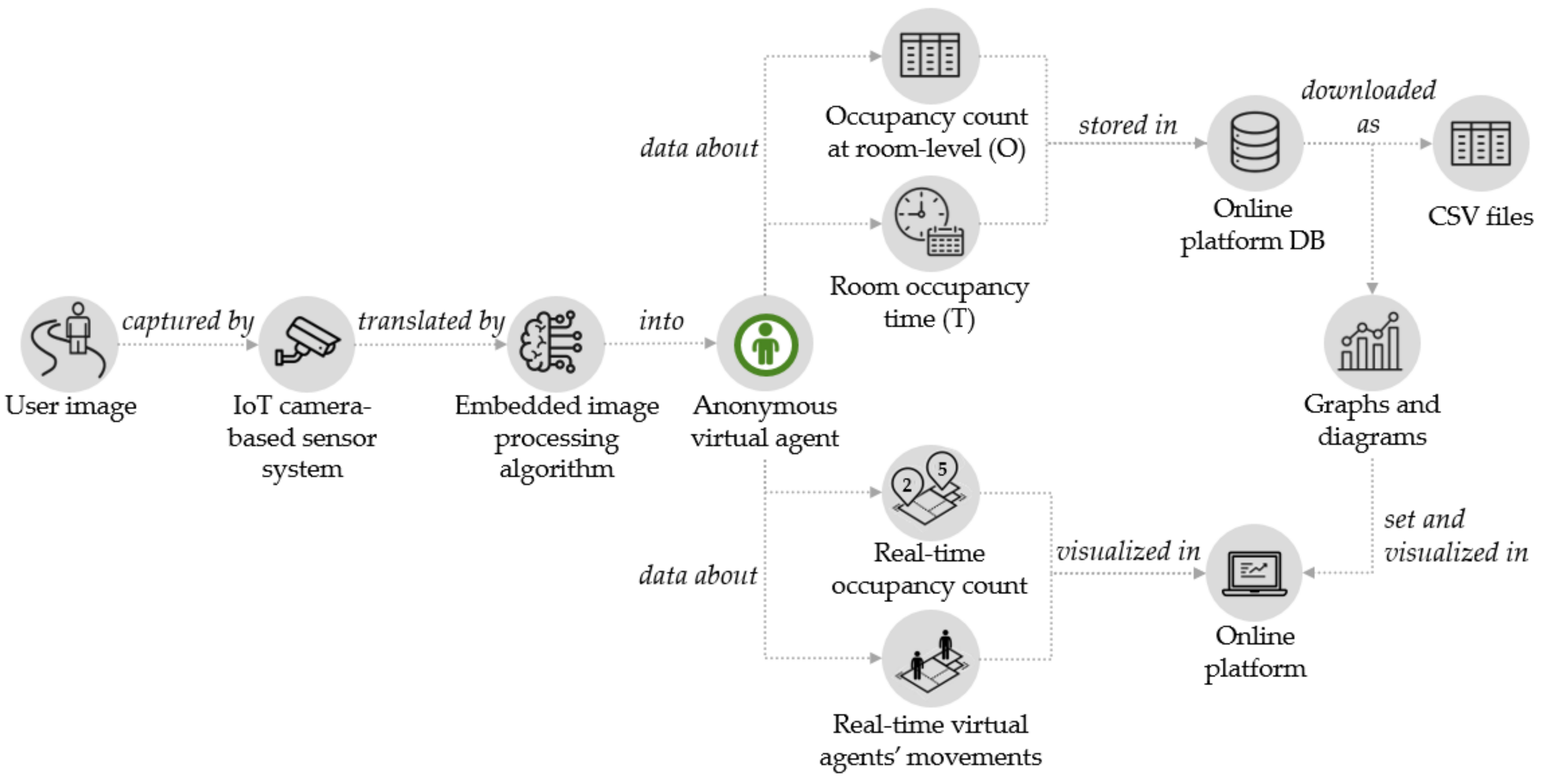
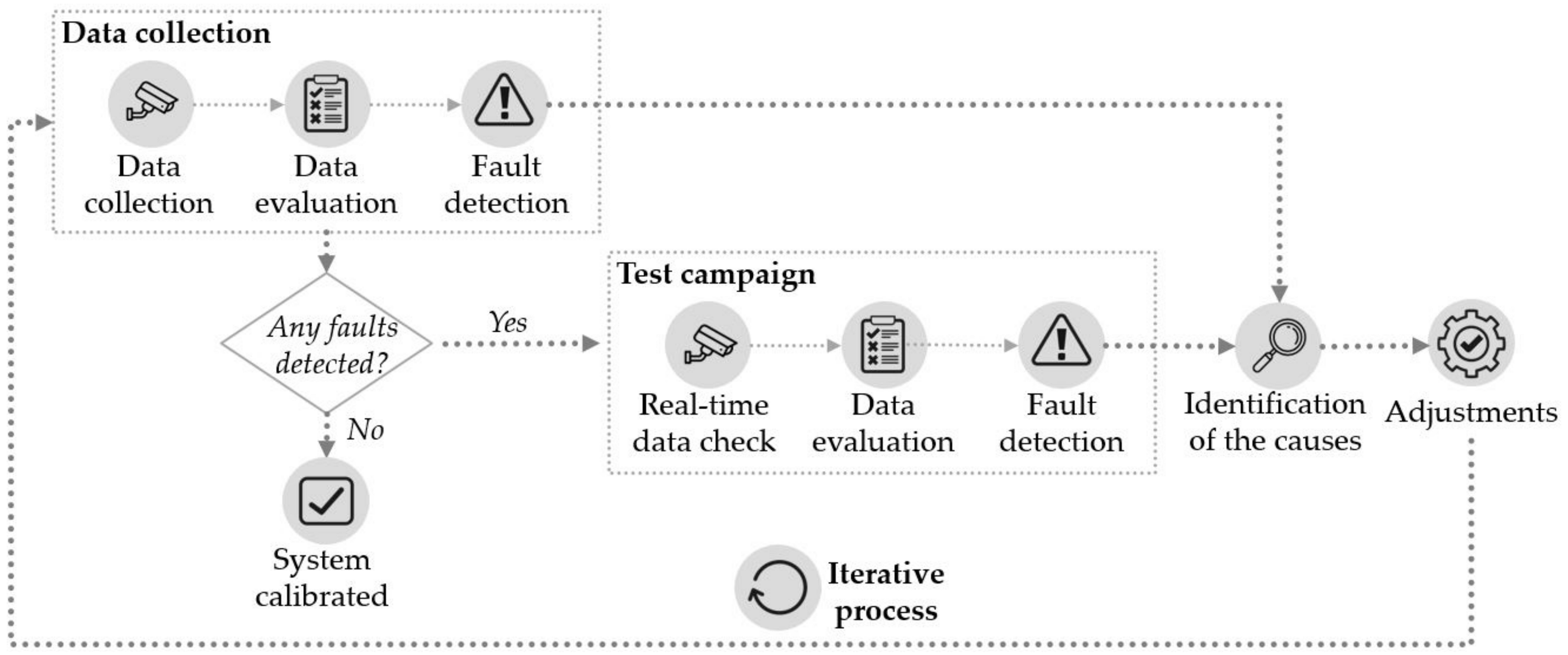
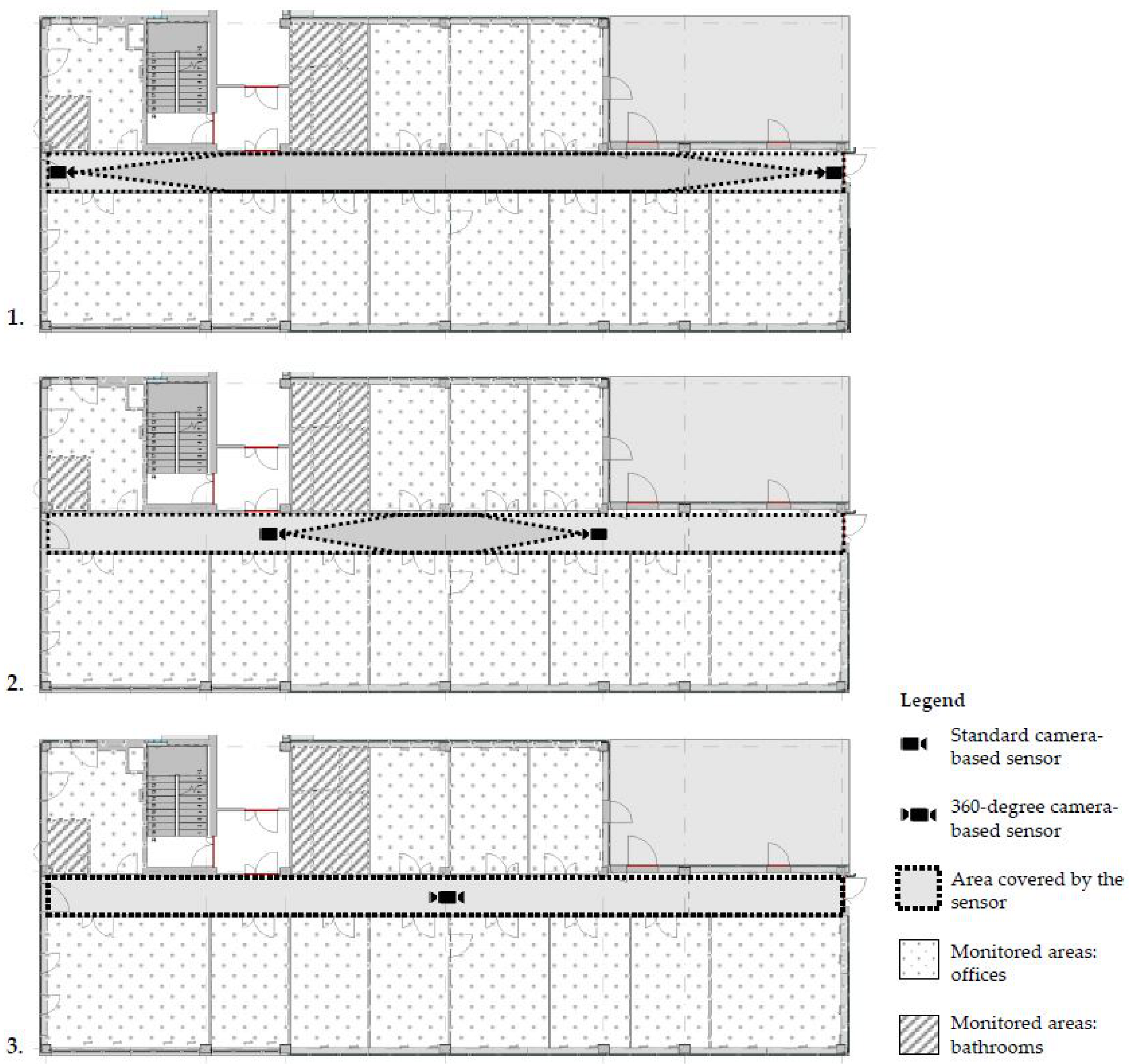
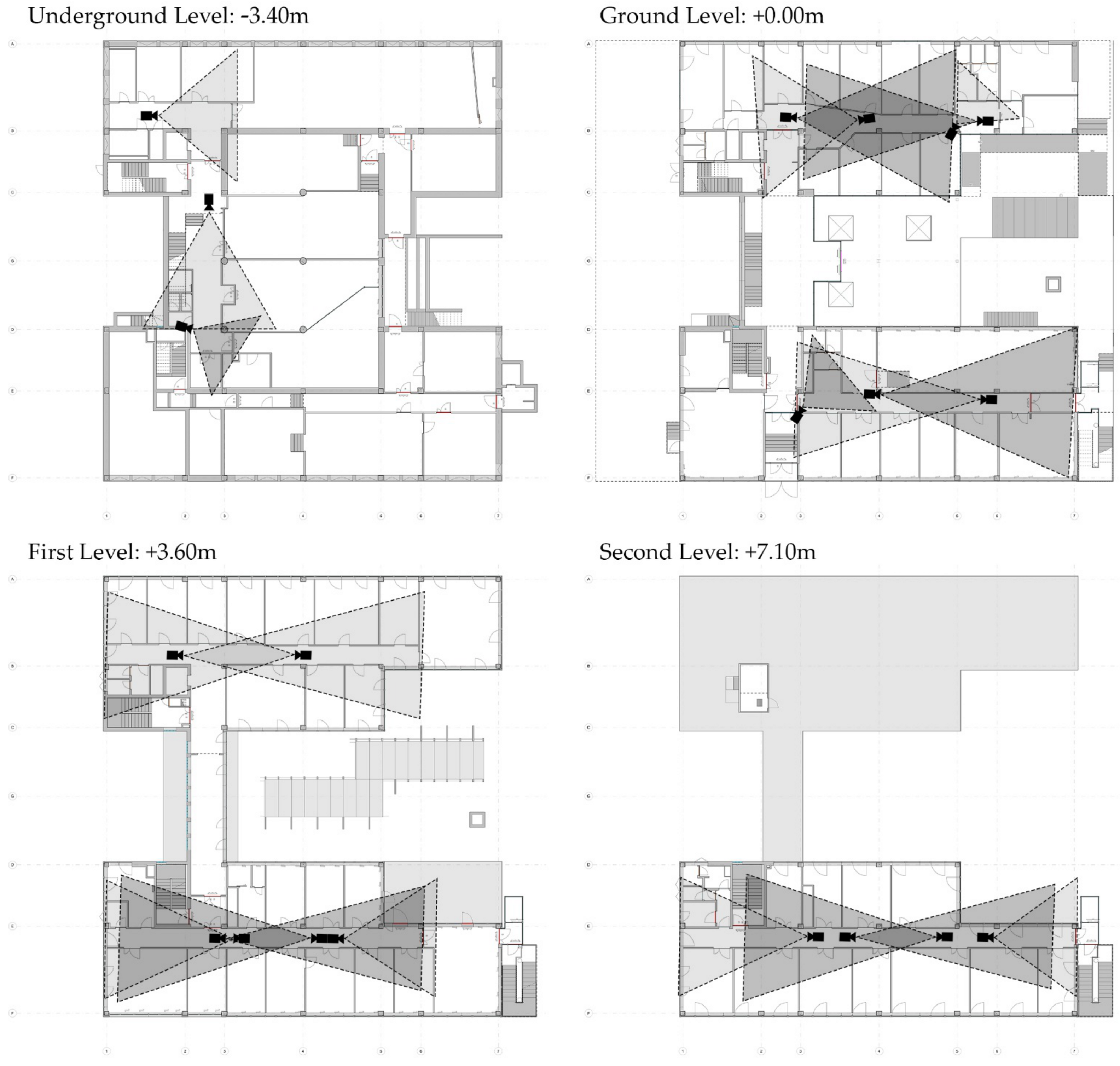
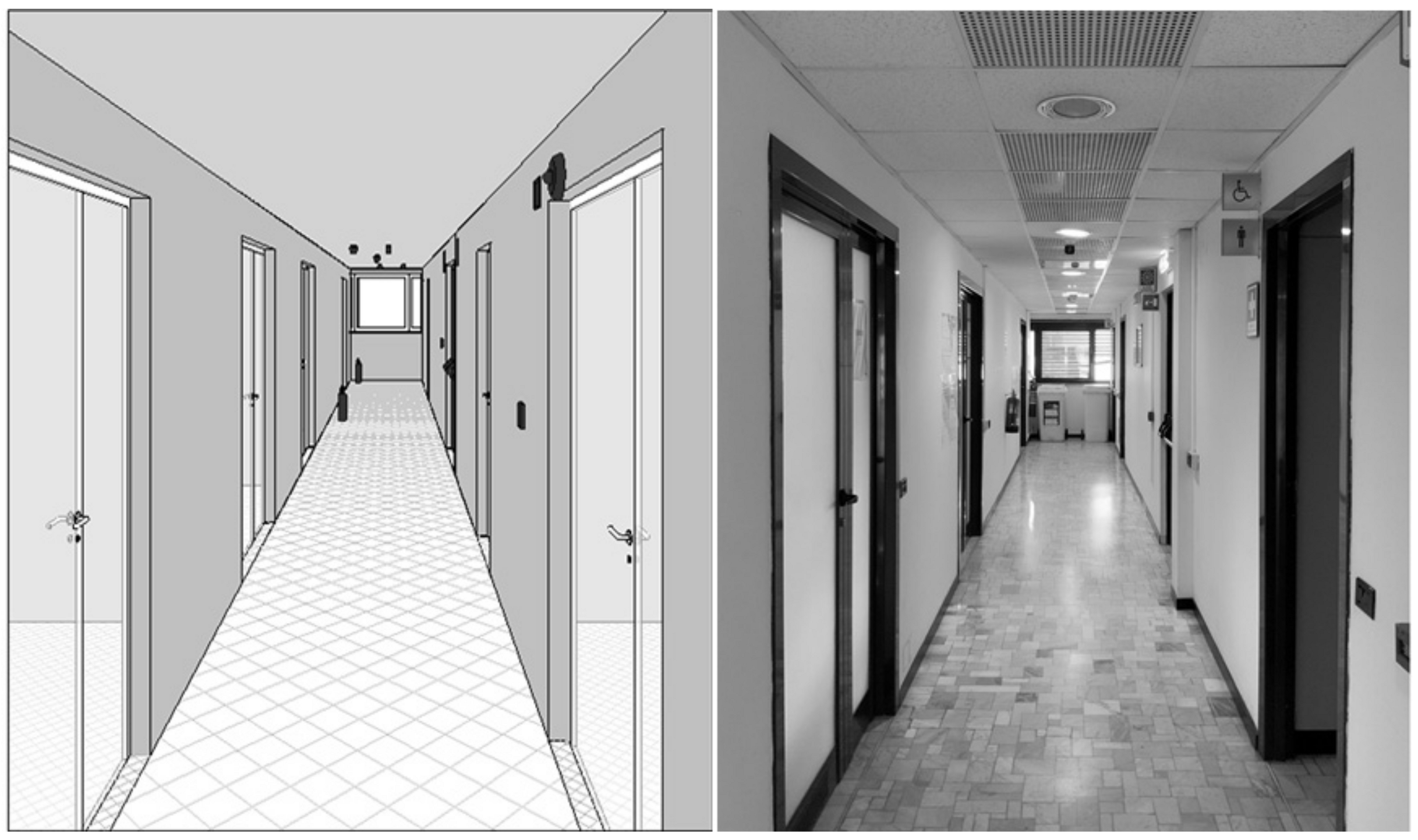
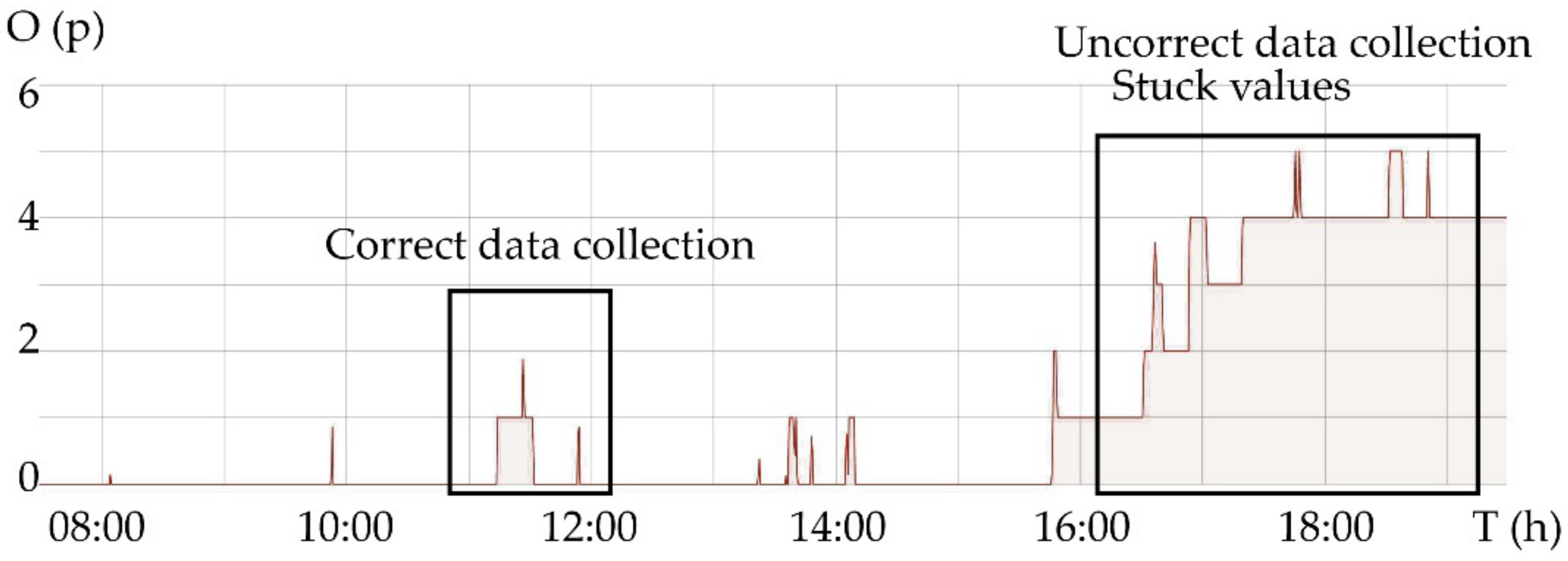
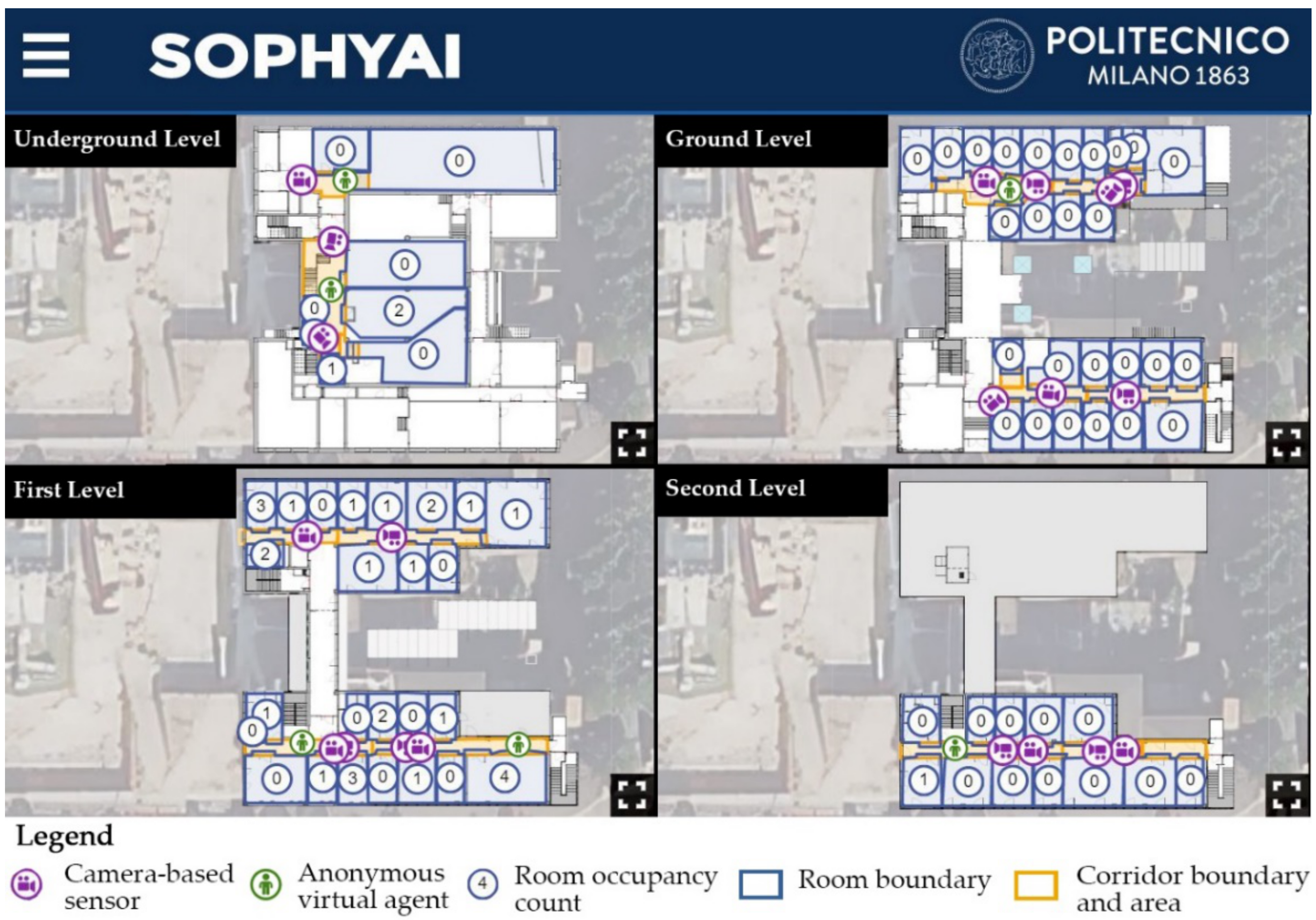



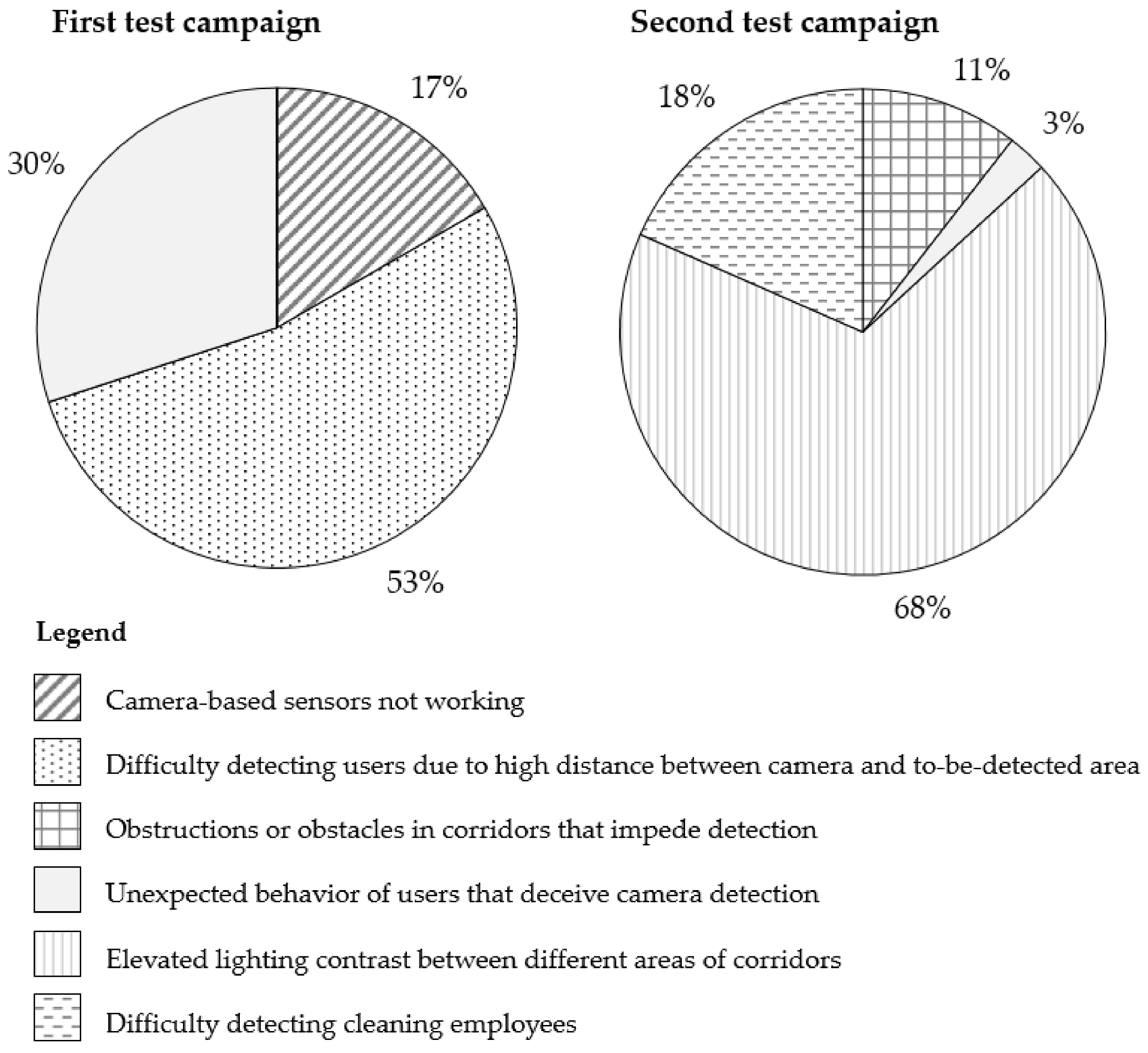
| Sensor Type | Main Aspects | Pros | Cons |
|---|---|---|---|
| Camera-based sensors [25,26] | Average accuracy of 97% | High accuracy Security and safety applications | Users detection only within field-of-view Privacy issues and Hawthorne effect |
| CO2 concentration change sensors [25,26,66] | Average accuracy of 94% | Often used in buildings No privacy issues | Less reliable than other type of sensors |
| Visual light and infrared (PIR) technologies [9,16,67,68] | High accuracy of 97% (unoccupied–occupied scenarios) Accuracy 93% (stationary and moving occupants) | High accuracy No privacy issues | Issues in detecting stationary occupants Users’ presence/absence detection only within the field-of-view |
| Radio frequency identification (RFID) sensors [9,15,69] | Accuracy of 88% (stationary occupants)Low accuracy 65% (moving occupants) | No privacy issuesAccess-control system applications | Low accuracy compared with other sensor systems |
| Wi-Fi connections [8,9,70,71,72,73,74] | Average accuracy of 80% | Available in most buildings | Privacy issues in visualizing and analyzing users’ connections |
| System Fault | Data Error in Collected Data | Data Error during Real-Time Test Campaign |
|---|---|---|
| Missing data: data are not collected | O = 0 p | O = 0 p |
| Outliers: one or more consecutive anomalous values | O < 0 p Values of O unacceptable for room dimensions, e.g., O = 50 p in a 10-square-meter office | O < 0 |
| Stuck values: those values occur when a sensor fails in detecting and a previously-detected value remains fixed | O > 0 outside the working hours | No correspondence between detected O and actual occupancy values, e.g., O > 0 in an empty room |
| Noise: it represents corrupted values | Not detectable in collected data | No correspondence between the virtual agent movements detected by the system and displayed in the platform, and the actual movements of operator B |
| Building Level | Space Type | Quantity | Monitored/Not Monitored |
|---|---|---|---|
| Underground Level | Laboratory/Office | 5 | Monitored |
| Bathroom | 2 | Monitored | |
| Classroom | 1 | Monitored | |
| Equipment Space | 3 | Not monitored | |
| Storage Room | 10 | Not monitored | |
| Ground Level | Laboratory/Office | 22 | Monitored |
| Bathroom | 3 | Monitored | |
| Meeting Room | 1 | Monitored | |
| Equipment Space | 1 | Not monitored | |
| First Level | Laboratory/Office | 21 | Monitored |
| Bathroom | 3 | Monitored | |
| Storage Room | 1 | Not monitored | |
| Terrace | 1 | Not monitored | |
| Second Level | Laboratory/Office | 10 | Monitored |
| Bathroom | 1 | Monitored | |
| Meeting Room | 1 | Monitored | |
| Equipment Space | 1 | Not monitored |
| Detected Issue, Evaluation Criteria, and Fault Classification | Cause Identification and Effects on the System | Proposed Hierarchized Adjustments |
|---|---|---|
| Data are not detected and collected. The system detects: (a)–(b): “Data = null”. This fault is classified as Missing data (a)–(b). | Camera-based sensors not working | Verification of sensor integrity, functioning, and connection |
| Incorrect boundary definition: areas that are not covered by boundaries; thus, they are not monitored | Perform a real time test to identify and verify the optimal boundary definition to minimize optical distortion between the 3D view of the camera and the 2D floor map visualization | |
| Obstructions or obstacles in corridors that impede users’ vision, like printers, waste bins for separate collection of paper, and presence of platforms for people with disabilities | (++) Remove the obstacle, if possible (+) Improve the deep learning algorithms for image recognition (--) Add a new camera and re-verify the system | |
| Behaviors of users that deceive the detection system: blind zone caused by unexpected doors left open | (++) Verify the possibility to avoid keeping the door open with a communication to the users (--) Add a new camera in a different position and re-verify the system | |
| Blind zone of the sensor: when two people are walking in corridors towards a sensor, the person further away from the camera generally is not detected | (++) Possibility to ignore the related error, which does not affect the next phase of statistical data analysis for the definition of the occupancy pattern (--) Add a new camera allowing a multiple detection of the same area and re-verify the system | |
| Fast increase/decrease of occupancy values. The system detects: (a)–(b): Negative or too high values of O. This fault is classified as Outliers (a)–(b). | Behaviors of users that deceive the detection system: difficulty in counting users when they are standing in front of the door opening the room or talking right in front of the entry of a room | (++) Add an automatic routine to the algorithm that records the occupancy data after a minimum user presence (+) Add an automatic routine to the algorithm that brings the count back to 0 when the displayed count is negative. (--) Enrich the system with the possibility of manually resetting rooms occupancy values in the presence of a wrong count (only in Administrator mode). |
| Unexpected length of the period of time the room is occupied (for bathrooms).(An example is shown in Figure 7) The system detects: (a): T > 15 min (b): Irregular real-time user detection This fault is classified as Stuck values (a) and Noise (b). | Too high distance of the camera from the to-be-detected area: irregular detection of users with a continuous detection/disappearance of a moving user, resulting in wrong collected data, as if there were multiple users closely entering the room one after the other | (++) Improve the deep learning algorithms for image recognition (--) Add new cameras and re-verify the system |
| Elevated lighting contrast between different areas of corridors: irregular detection of users with a continuous detection/disappearance of a moving user, resulting in wrong collected data, as if there were multiple users closely entering the room one after the other | (++) Review the camera settings regarding lighting and contrast (--) Add a new camera in the brighter zone and re-verify the system | |
| Unexpected moment of the day in which the room is continuously occupied (for offices) The system detects: (a): O > 0 outside working hours (b): Irregular real-time user detection This fault is classified as Stuck values (a) and Noise (b). | Too high distance of the camera from the to-be-detected area: irregular detection of users with a continuous detection/disappearance of a moving user, resulting in wrong collected data as if there were multiple users closely entering the room one after the other. Due to the higher value of O than the real number of people in the room, when people leave, O does not return to zero, with remaining values of O > 0 even after the end of the working day | (++) Improve the deep learning algorithms for image recognition (--) Add new cameras and re-verify the system |
| Elevated lighting contrast between different areas of corridors: irregular detection of users with a continuous detection/disappearance of a moving user, resulting in wrong collected data as if there were multiple users closely entering the room one after the other. Due to the higher value of O than the real number of people in the room, when people leave, O does not return to zero, with remaining values of O > 0 even after the end of the working day | (++) Review the camera settings regarding lighting and contrast (--) Add a new camera in the brighter zone and re-verify the system | |
| Difficulty detecting two people entering in a room close together and/or quickly. This causes wrong collected data as if there were multiple users closely entering the room one after the other. Due to the higher value of O than the real number of people in the room, when people leave, O does not return to zero, with remaining values of O > 0 even after the end of the working day | (++) Possibility to ignore the related error, which does not affect the next phase of statistical data analysis for the definition of the occupancy pattern (--) Add a new camera allowing a multiple detection of the same area and re-verify the system | |
| Difficulty detecting cleaning employees due to the presence of the cleaning trolley, which impedes a complete view of the operator. Therefore, often the cleaning employee is detected entering the room (O = +1) but not leaving, so the value O remains unchanged | (++) Optimization and training of the recognition algorithm to identify the cleaning trolley by excluding the cleaning service employee in the occupancy count (--) Add a new camera allowing a multiple detection of the same area and re-verify the system |
Publisher’s Note: MDPI stays neutral with regard to jurisdictional claims in published maps and institutional affiliations. |
© 2021 by the authors. Licensee MDPI, Basel, Switzerland. This article is an open access article distributed under the terms and conditions of the Creative Commons Attribution (CC BY) license (https://creativecommons.org/licenses/by/4.0/).
Share and Cite
Seghezzi, E.; Locatelli, M.; Pellegrini, L.; Pattini, G.; Di Giuda, G.M.; Tagliabue, L.C.; Boella, G. Towards an Occupancy-Oriented Digital Twin for Facility Management: Test Campaign and Sensors Assessment. Appl. Sci. 2021, 11, 3108. https://doi.org/10.3390/app11073108
Seghezzi E, Locatelli M, Pellegrini L, Pattini G, Di Giuda GM, Tagliabue LC, Boella G. Towards an Occupancy-Oriented Digital Twin for Facility Management: Test Campaign and Sensors Assessment. Applied Sciences. 2021; 11(7):3108. https://doi.org/10.3390/app11073108
Chicago/Turabian StyleSeghezzi, Elena, Mirko Locatelli, Laura Pellegrini, Giulia Pattini, Giuseppe Martino Di Giuda, Lavinia Chiara Tagliabue, and Guido Boella. 2021. "Towards an Occupancy-Oriented Digital Twin for Facility Management: Test Campaign and Sensors Assessment" Applied Sciences 11, no. 7: 3108. https://doi.org/10.3390/app11073108
APA StyleSeghezzi, E., Locatelli, M., Pellegrini, L., Pattini, G., Di Giuda, G. M., Tagliabue, L. C., & Boella, G. (2021). Towards an Occupancy-Oriented Digital Twin for Facility Management: Test Campaign and Sensors Assessment. Applied Sciences, 11(7), 3108. https://doi.org/10.3390/app11073108







